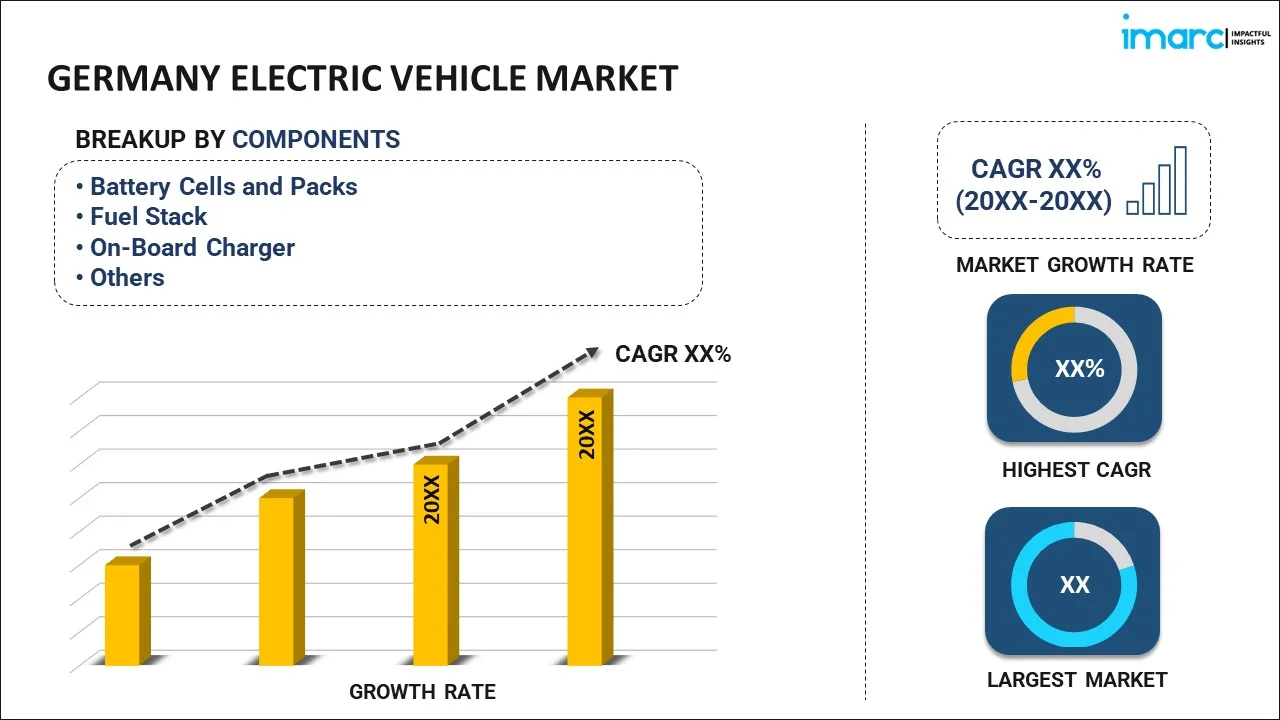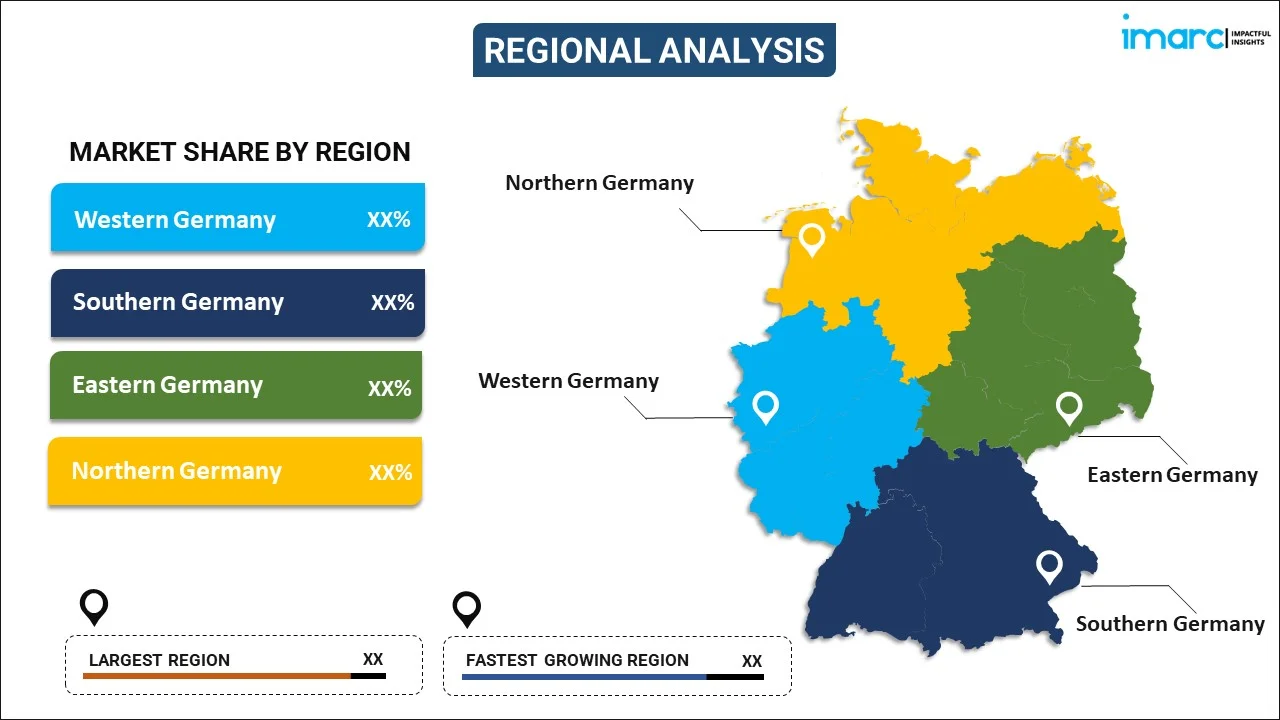
Germany Electric Vehicle Market Report by Component (Battery Cells and Packs, Fuel Stack, Onboard Chargers, Electric Motor, Brake, Wheel and Suspension, Body and Chassis, and Others), Propulsion Type (Battery Electric Vehicle (BEV), Fuel Cell Electric Vehicle (FCEV), Plug-In Hybrid Electric Vehicle (PHEV)), Vehicle Type (Passenger Vehicles, Commercial Vehicles, and Others), and Region 2025-2033
Germany Electric Vehicle Market Overview:
The Germany electric vehicle market size is projected to exhibit a growth rate (CAGR) of 23.62% during 2025-2033. The market is driven by supportive government incentives, extensive charging infrastructure development, stringent emissions regulations, and ongoing technological advancements that are increasing environmentally friendly transportation options.
|
Report Attribute
|
Key Statistics
|
|---|---|
|
Base Year
|
2024 |
|
Forecast Years
|
2025-2033 |
|
Historical Years
|
2019-2024
|
| Market Growth Rate (2025-2033) | 23.62% |
Germany Electric Vehicle Market Trends:
Rising Fuel Costs and Supportive Government Policy:
The rising expense of traditional fossil fuels such as gasoline and diesel, resulted in the adoption of electric vehicles (EVs). Moreover, customers are now looking into electric alternatives to reduce their reliance on gasoline and supporting environmental sustainability initiatives. Along with this, the rising expense of gasoline, and the appeal of electric vehicles (EVs) is due to the growing awareness of climate change and the need to minimize carbon footprints. Presently, the unleaded gasoline price reached EUR 1.87 per litre and diesel prices reached EUR 1.67 per litre in Germany. Additionally, it implemented ambitious strategies to address rising energy expenses, aiming to stabilize domestic demand and alleviate pressure on household and corporate finances from December 2021 to November 2022. As a result, this trend has accelerated customer desire for electric vehicles (EVs), spurring innovation and investment in electric mobility solutions by the automotive industry.
Increasing Electric Car Adoption:
The rapid uptake of electric vehicles (EVs) in Germany is indicative of a more widespread worldwide trend toward environmentally friendly transportation. Additionally, government incentives, growing environmental consciousness, and improvements in electronic vehicle (EV) technology such as longer battery life and better infrastructure for charging are contributing to the market growth. According to data from the Federal Motor Transport Authority (KBA), Germany witnessed a remarkable increase in e-car registrations by more than 37% compared to the first seven months of 2023 as compared to the same time the previous year. According to the KBA, there were about 269,000 new electric vehicles on the road, and battery-operated electric vehicles (EVs) made up 16.4% of all new vehicle registrations. Thus, Germany is creating a solid basis for a future dominated by electric transportation with programs such as tax incentives, subsidies, and R&D spending, promising more prosperity and innovation across the region.
Germany Electric Vehicle Market News:
- June 2023: Ford opened the state-of-the-art Cologne electric vehicle center in Germany, where its newest electric passenger cars will be produced for European customers. The center, located at the ancient Niehl factory represents a significant $2 billion investment and demonstrates Ford's belief in the manufacturing capabilities of Germany and the prospects for European car production. The complex, which covers 125 hectares, has a new production line, battery assembly, and advanced automation that allow for an annual output of more than 250,000 electric vehicles. After the success of vehicles such as the Mustang Mach-E, E-Transit, and F-150 Lightning, Ford unveiled its fourth worldwide electric vehicle (EV) recently, the electric Explorer. This will be the first electric car made at the Cologne factory, and it will be followed by a sporty crossover variant.
- April 2024: Mercedes-Benz G 580 featuring EQ Technology was launched similar to its conventionally powered counterparts, it adheres to a ladder-frame design, offers a selectable LOW RANGE off-road gear reduction system, independent front suspension, and a solid rear axle. In addition, it offers the G-TURN, G-STEERING, and intelligent off-road crawl function, combined with the advanced drive concept and adaptable transmissions, delivering distinctive driving dynamics.
Germany Electric Vehicle Market Segmentation:
IMARC Group provides an analysis of the key trends in each segment of the market, along with forecasts at the country level for 2025-2033. Our report has categorized the market based on component, propulsion type and vehicle type.
Component Insights:

- Battery Cells and Packs
- Fuel Stack
- On-Board Charger
- Electric Motor
- Brake, Wheel and Suspension
- Body and Chassis
- Others
The report has provided a detailed breakup and analysis of the market based on the component. This includes battery cells and packs, fuel stack, onboard chargers, electric motor, brake, wheel and suspension, body and chassis, and others.
Propulsion Type Insights:
- Battery Electric Vehicle (BEV)
- Fuel Cell Electric Vehicle (FCEV)
- Plug-In Hybrid Electric Vehicle (PHEV)
The report has provided a detailed breakup and analysis of the market based on the propulsion type. This includes battery electric vehicle (BEV), fuel cell electric vehicle (FCEV) and plug-in hybrid electric vehicle (PHEV).
Vehicle Type Insights:
- Passenger Vehicles
- Commercial Vehicles
- Others
A detailed breakup and analysis of the market based on the vehicle type have also been provided in the report. This includes passenger vehicles, commercial vehicles, and others.
Regional Insights:

- Western Germany
- Southern Germany
- Eastern Germany
- Northern Germany
The report has also provided a comprehensive analysis of all the major regional markets, which include Western Germany, Southern Germany, Eastern Germany, and Northern Germany.
Competitive Landscape:
The market research report has also provided a comprehensive analysis of the competitive landscape. Competitive analysis such as market structure, key player positioning, top winning strategies, competitive dashboard, and company evaluation quadrant has been covered in the report. Also, detailed profiles of all major companies have been provided.
Germany Electric Vehicle Market Report Coverage:
| Report Features | Details |
|---|---|
| Base Year of the Analysis | 2024 |
| Historical Period | 2019-2024 |
| Forecast Period | 2025-2033 |
| Units | Billion USD |
| Scope of the Report | Exploration of Historical and Forecast Trends, Industry Catalysts and Challenges, Segment-Wise Historical and Predictive Market Assessment:
|
| Components Covered | Battery Cells and Packs, Fuel Stack, Onboard Chargers, Electric Motor, Brake, Wheel and Suspension, Body and Chassis, Others |
| Propulsion Types Covered | Battery Electric Vehicle (BEV), Fuel Cell Electric Vehicle (FCEV), Plug-In Hybrid Electric Vehicle (PHEV) |
| Vehicle Types Covered | Passenger Vehicles, Commercial Vehicles, Others |
| Regions Covered | Western Germany, Southern Germany, Eastern Germany, Northern Germany |
| Customization Scope | 10% Free Customization |
| Post-Sale Analyst Support | 10-12 Weeks |
| Delivery Format | PDF and Excel through Email (We can also provide the editable version of the report in PPT/Word format on special request) |
Key Questions Answered in This Report:
- How has the Germany electric vehicle market performed so far and how will it perform in the coming years?
- What has been the impact of COVID-19 on the Germany electric vehicle market?
- What is the breakup of the Germany electric vehicle market on the basis of component?
- What is the breakup of the Germany electric vehicle market on the basis of propulsion type?
- What is the breakup of the Germany electric vehicle market on the basis of vehicle type?
- What are the various stages in the value chain of the Germany electric vehicle market?
- What are the key driving factors and challenges in the Germany electric vehicle?
- What is the structure of the Germany electric vehicle market and who are the key players?
- What is the degree of competition in the Germany electric vehicle market?
Key Benefits for Stakeholders:
- IMARC’s industry report offers a comprehensive quantitative analysis of various market segments, historical and current market trends, market forecasts, and dynamics of the Germany electric vehicle market from 2019-2033.
- The research report provides the latest information on the market drivers, challenges, and opportunities in the Germany electric vehicle market.
- Porter's five forces analysis assist stakeholders in assessing the impact of new entrants, competitive rivalry, supplier power, buyer power, and the threat of substitution. It helps stakeholders to analyze the level of competition within the Germany electric vehicle industry and its attractiveness.
- Competitive landscape allows stakeholders to understand their competitive environment and provides an insight into the current positions of key players in the market.
Need more help?
- Speak to our experienced analysts for insights on the current market scenarios.
- Include additional segments and countries to customize the report as per your requirement.
- Gain an unparalleled competitive advantage in your domain by understanding how to utilize the report and positively impacting your operations and revenue.
- For further assistance, please connect with our analysts.
 Inquire Before Buying
Inquire Before Buying
 Speak to an Analyst
Speak to an Analyst
 Request Brochure
Request Brochure
 Request Customization
Request Customization




.webp)




.webp)












